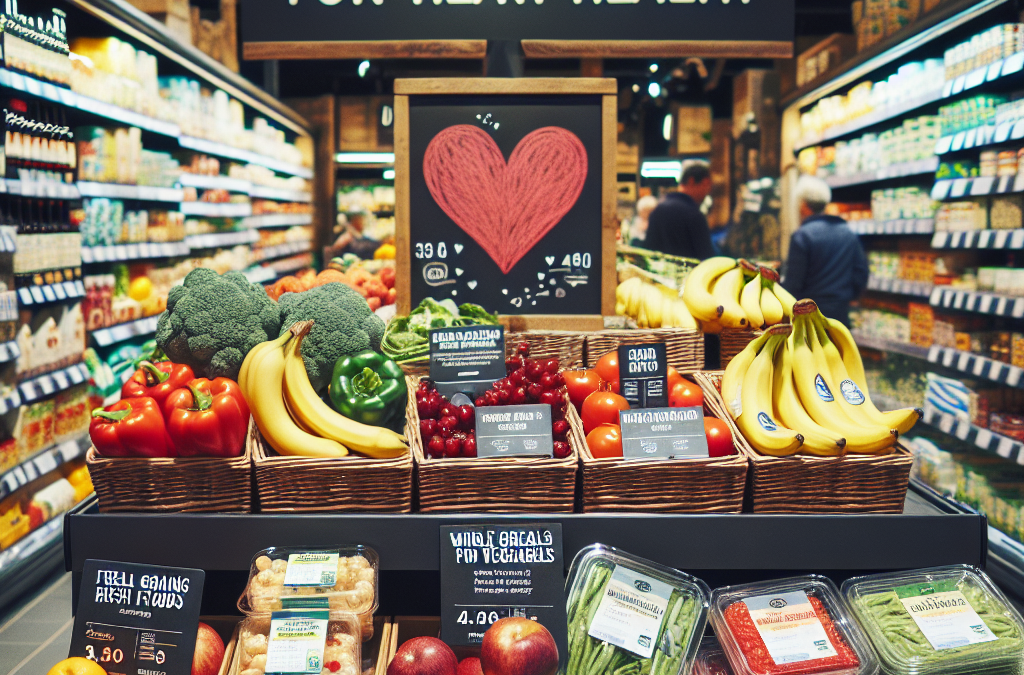Emphasizing Fresh Fruits and Vegetables
The Benefits of Colorful Produce
Let me tell you, incorporating fresh fruits and veggies into my diet has been a game changer for my heart health! When I think about all the vibrant colors at the market, I can’t help but feel energized. Each hue represents different nutrients that contribute to heart health. For example, red tomatoes are packed with lycopene, which is known to help lower cholesterol.
Plus, leafy greens like spinach and kale are not just ‘rabbit food.’ They are rich in antioxidants and vitamins that support better circulation. One of my favorite hacks is to throw spinach into my smoothies. It doesn’t even change the taste—just the health benefits soar!
And let’s not ignore berries! Strawberries, blueberries, and blackberries are high in fiber, which can help maintain healthy blood pressure levels. Honestly, they make for such a refreshing snack. You toss a handful on your yogurt, and bam! You’ve got a heart-healthy treat.
Cooking with Fresh Ingredients
Using fresh produce in my meals is like giving my heart a treat. I’ve found that the more I cook with whole ingredients, the less I crave processed foods. When I whip up a stir-fry, I like to showcase seasonal veggies—it turns dinner into a colorful feast.
Thinking about soups? Trust me; you can create a hearty vegetable soup from scratch that’s not only filling but packed with nutrients. I grab whatever I’m feeling, toss it in a pot, and let it simmer. There’s something really therapeutic about homemade soup!
And don’t get me started on leaf wraps instead of bread! I love to use sturdy greens like romaine. You can fill them with all sorts of goodness—grilled chicken, beans, or just roasted veggies. It’s a fun and tasty way to enjoy a low-carb meal that’s kind to your heart.
Snacking Smartly
Snacks are where I really had to get creative! Instead of reaching for chips, I now munch on veggie sticks and hummus more often than not. It feels good to fuel my body with something nutritious instead of junk.
I’ve also embraced fruits as my go-to snack. When I’m craving something sweet, I’ll grab an apple or a handful of nuts. Apples have pectin, which can help lower cholesterol, and nuts are full of healthy fats that keep my heart happy.
And there’s nothing wrong with a good old-fashioned fruit smoothie! I blend up what I have—some spinach, a banana, and maybe a bit of almond milk. It’s like a little party in my mouth, and I know it’s doing wonders for my heart!
Incorporating Whole Grains
The Essence of Whole Grains
A few years back, I started swapping out refined grains for whole ones, and wow, what a difference it made! Whole grains like quinoa, oats, and brown rice are packed with fiber, which is fantastic for heart health. They help to lower cholesterol and manage blood pressure.
Now, if you thought whole grains were only boring, think again! Quinoa is not just a grain; it’s a complete protein! You can toss it into salads, use it as a base for your dishes, or even enjoy it as a breakfast porridge. It’s versatile and super nutritious.
Oats have become a staple in my mornings. I’ll cook them with some almond milk and top them with berries. It’s filling, and I feel great knowing I’ve started the day with something heart-healthy!
Reading Labels Wisely
I can’t stress enough the importance of reading labels. It took some time, but now I’ve got the hang of it. When looking for whole grain products, I always check for “100% whole grain” on the packaging. Otherwise, I might just be wasting my money.
One sneaky thing I’ve noticed is that many items labeled as “multigrain” aren’t actually whole grain. This kept tripping me up! So, always read the ingredients, and aim for products that list whole grains first.
Learning to navigate labels has empowered me to choose better options for my heart. I even challenge myself to find new whole grain recipes online. It’s turned into a fun little project!
Meal Preparation with Whole Grains
Meal prep has been a lifesaver for me. When I started cooking large batches of whole grains, it made it easier to incorporate them into my daily meals. I’ll often prep a bunch of quinoa or brown rice on the weekend, and then use them throughout the week in salads, wraps, or as sides.
What makes this so great is that I save time and ensure I’m eating something nutritious! Plus, I get creative with my seasonings; a little garlic and herbs can transform plain grains into a delicious dish!
On top of that, knowing I’ve got a heart-healthy grain option ready to go keeps my snacking in check. It’s a win-win every time. Less processed junk, fancier meals, and a happy heart!
Heart-Healthy Fats
Understanding Good vs. Bad Fats
Let’s talk fats! It used to be all about cutting fats out, but now I see them a little differently. Learning about good fats vs. bad fats has made my meals way more flavorful and heart-friendly. Avocados, nuts, and olive oil are all in my kitchen rotation now.
Avocado on toast? Yes, please! It’s my favorite breakfast, not just because it’s trendy, but because it’s packed with good fats that keep my heart healthy. I also love using extra virgin olive oil for cooking—it gives my dishes that Mediterranean flair without the bad stuff.
There’s a big difference between those healthy fats and trans fats found in many processed foods. I had to break up with those. It’s totally worth learning about and making the switch!
Incorporating Healthy Fats in Meals
My meals have turned into these little masterpieces by incorporating healthy fats. A drizzle of olive oil over a salad, some nuts sprinkled on my yogurt, or using avocado instead of mayo in sandwiches have been fabulous changes.
Get an Amazing Discount on the Best Certified Organic Whole Food Supplement!
And let’s not forget about fish! Salmon and mackerel are loaded with omega-3 fatty acids, which are awesome for heart health. I aim to include fish in my meals at least a couple of times a week—it’s easy to prepare and so satisfying.
Creating heart-healthy meals has become a personal challenge, and I love sharing my favorites with friends. It feels good to not only eat well but to inspire others to join the journey!
Mindful Snacking Choices
Let’s be real, snacks can be tricky! But I found that choosing snacks with healthy fats keeps me feeling full longer. Instead of loading up on sugary treats, I switch to things like nut butter with apples or homemade trail mix.
When I need a crunch, I enjoy roasted chickpeas. They’re not only delicious but pack protein and fiber too. And the best part? They’re super easy to make!
Being mindful of my snacking has made a world of difference. It ensures I’m not reaching for junk food, and I can enjoy my snacks without guilt. Who knew snacking could be both satisfying and healthy?
Legumes for Protein and Fiber
The Power of Beans and Lentils
Once I discovered legumes, it was like opening a treasure chest for my heart health! Beans, lentils, and peas are not only loaded with protein but also high in fiber, helping to maintain healthy cholesterol levels. They save me from feeling sluggish after meals.
Using lentils in soups or stews adds that hearty texture while being a powerhouse of nutrition. Plus, they cook up quickly, so it’s a no-brainer for weeknight dinners!
Beans are my secret weapon for making salads more filling. Black beans, kidney beans, or chickpeas thrown into a salad? It’s a game changer. Who knew healthy eating could be this tasty?
Experimenting with Legume Recipes
Trying out new recipes has become a passion of mine, and legumes are always an ingredient I love experimenting with. From bean burgers to lentil shepherd’s pie, the possibilities are endless. I even made chili with three types of beans, and it was a hit!
Sometimes I even sneak them into dishes that wouldn’t usually have them. Like, I’ll add pureed beans into pasta sauces. No one even knows, but I do, and it’s brilliant!
Cooking with legumes might take a little trial and error, but it’s super rewarding. Plus, many legumes are inexpensive and easy to keep stocked. They totally fit into my budget while keeping my heart happy!
Snacks and Sides with Legumes
Using legumes as snacks has been a fun way to switch things up. I now make hummus at home! It’s just chickpeas, tahini, garlic, and a splash of lemon—so simple and delicious.
Sometimes, I toss together a quick bean salad for a side dish; it’s filling and looks gorgeous on the plate. Just a little olive oil, vinegar, and perhaps some herbs, and voilà!
Integrating legumes into snacks and sides has made my meals both diverse and healthy. This discovery led to some great dinner parties where everyone gets to explore different dishes together—heart health never tasted so good!
Final Thoughts and Healthy Habits
Keeping my heart health on track has been an enjoyable journey, and it all started with these whole foods. I’ve learned to make heart-healthy choices that don’t feel like a burden but rather a celebration of vibrant flavors and textures.
I hope that sharing my experiences encourages you to dive into creating your own nourishing meals. It’s amazing to take charge of our health with wholesome ingredients while enjoying every bite.
Remember, we’re all in this together! Small shifts in what we eat can lead to big changes in our overall heart health. I’m excited for your journey ahead!
FAQs
1. What are Whole Foods?
Whole foods are foods that are as close to their natural state as possible. This can include fruits, vegetables, whole grains, nuts, and seeds—basically, foods that don’t come with a long list of additives or preservatives!
2. Why are whole foods important for heart health?
Whole foods are typically high in nutrients, fiber, and antioxidants, which can help maintain a healthy heart by lowering cholesterol, controlling blood pressure, and reducing the risk of heart disease.
3. Can I still enjoy snacks while focusing on heart health?
Absolutely! Healthy snacking is encouraged. Try opting for nuts, fruits, or veggies with hummus, which can satisfy your cravings without compromising your heart health.
4. Are all fats bad for my heart?
Not at all! It’s essential to differentiate between healthy fats (like those found in avocados and nuts) and unhealthy trans fats (found in many processed foods). Balancing healthy fats is very beneficial.
5. How can I start incorporating more whole foods into my diet?
Start small! Try adding a serving of fruits or veggies to your meals, swap out white rice for brown, or experiment with beans in recipes. It’s all about gradually enhancing your diet.




